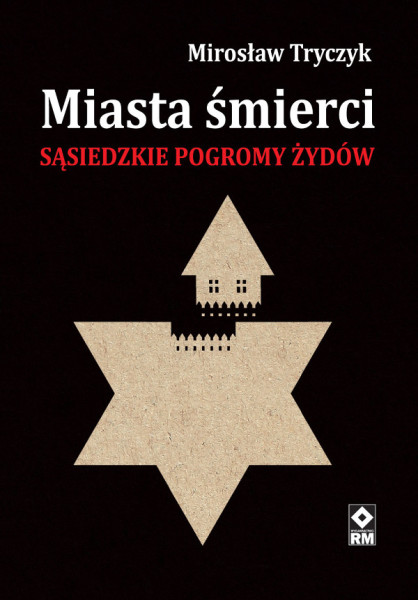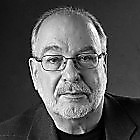 Szansę wykorzystałem. „Miasta śmierci” napisałem, by uczcić pamięć ofiar, a nie, by oskarżać [Polemika autora z recenzją Natalii Aleksiun]
Szansę wykorzystałem. „Miasta śmierci” napisałem, by uczcić pamięć ofiar, a nie, by oskarżać [Polemika autora z recenzją Natalii Aleksiun]
Mirosław Tryczyk
Natalia Aleksiun w recenzji mojej książki pod wymownym tytułem: „Zmarnowana szansa. O «Miastach śmierci» Mirosława Tryczyka” postawiła kilka zarzutów, które należałoby potraktować poważnie, pod jednym wszak warunkiem: gdyby były prawdziw

Recenzje merytoryczne, choć surowe, dla każdego autora są ważne, bo pozwalają rozwijać warsztat i doskonalić umiejętności. Jednak podziękowania dla Natalii Aleksiun przychodzą mi z trudem, ponieważ jej recenzję do merytorycznych trudno zaliczyć i raczej traktować ją mi wypada jako głos czytelniczki, która chciałaby podzielić się tym, jak sobie moją książkę wyobraziła. Oczywiście, opinia każdego czytelnika ma znaczenie i gdyby została zaprezentowana jako taka, nie miałbym żadnych zastrzeżeń, tym bardziej że o gustach dyskutować nie wypada. Niemniej jednak recenzja Natalii Aleksiun została przedstawiona na łamach „Kultury Liberalnej” jako recenzja krytyczna, której bez kilku choćby słów wyjaśnień pozostawić nie mogłem.
Po kolei.
Przykro mi, że Natalia Aleksiun zarzuca mi niepotrzebne zamieszczenie w książce zdjęcia nagiej kobiety, żydowskiej ofiary pogromu. Twierdzi zresztą, że umieściłem je w książce na stronie 355, choć znajdziemy je na stronie 415 oraz kolejne na stronie 475, co łatwo można sprawdzić.
Przykro mi jednak nie dlatego, że Natalia Aleksiun myli strony, lecz dlatego, że zdaje się zarzucać mi bezsensowne epatowanie nagością ofiary pogromu. Tymczasem na wspomnianym zdjęciu nie nagość ofiary jest ważna. Zapewniam, iż nie jest ona tam użyta w jakimkolwiek seksualnym kontekście, ale po to, by uwypuklić bezbronność ofiary wobec otaczającego ją tłumu cywilów – mieszkańców miasta czy sąsiadów, których sylwetki widać w tle. Widok sprawców, którzy obstąpili kobietę i beznamiętnie przyglądają się jej tragedii, napawa grozą, gdyż zdajemy już sobie sprawę z tego, co zrobili. Widzimy nie buty żołdaka niemieckiego, ale eleganckie, kobiece pantofle, lakierki mężczyzny, chude nogi jakiegoś wyrostka. Te zdjęcia porażają, napawają nas przerażeniem. Wielka szkoda, że Natalia Aleksiun zinterpretowała te zdjęcia tak jednoznacznie.
Natalia Aleksiun zdaje się również sugerować w swoim tekście, że winę za mordy na Podlasiu w 1941 r. przypisuję Polakom. Pisze: „W istocie można odnieść wrażenie, że autor chce czytelnika skonfrontować przede wszystkim z tym obrazem okupacji niemieckiej, w którym Polacy stają się sprawcami, a nie ofiarami czy choćby świadkami zbrodni dokonywanych na Żydach”. Nic bardziej mylnego. Zarówno w książce „Miasta śmierci. Sąsiedzkie pogromy Żydów”, jak i w licznych tekstach, jakie na ten temat pisałem, zawsze podkreślałem, że po ucieczce Sowietów w 1941 r. władzę w niektórych miasteczkach Podlasia przejęli ich polscy mieszkańcy, tworząc straże, milicje, koła samoobrony. Wbrew temu jednak, co twierdzi Natalia Aleksiun, w książce piszę również, że wskutek rozpadu struktur państwa polskiego, spowodowanego działaniami wojennymi i terrorem okupacyjnym, polscy mieszkańcy wespół z niemieckimi komandami śmierci przeprowadzili część pogromów w podlaskich miasteczkach. Nie pomijam roli okupacji sowieckiej i niemieckiej. Mówię również o przypadkach ratowania Żydów przez Polaków, ale jedynie tam, gdzie są do tego twarde, udokumentowane podstawy. Nie uprawiam fantazjowania na ten temat. Nie milczę za to, choć robiono tak do tej pory w polskiej historiografii, o wpływie ideologii polskiego nacjonalizmu i wypływającej z niej przemocy, której przykładem są pogromy dokonywane przez ONR w okresie międzywojennym na tamtym terenie m.in. w Radziłowie, oraz o niechlubnej roli kleru katolickiego. Co z zadowoleniem odnotowuje w recenzji także Natalia Aleksiun.
Mirosław Tryczyk: – Nie pomijam roli okupacji sowieckiej i niemieckiej. Mówię również o przypadkach ratowania Żydów przez Polaków, ale jedynie tam, gdzie są do tego twarde, udokumentowane podstawy.
Recenzentka zarzuca mi jednak zaraz, że nie wspomniałem w bibliografii dwóch badaczy zajmujących się zagadnieniem. Nie jest to zarzut poważny. Natalia Aleksiun zarzuca mi, że przepisuję dwie (!) frazy zdaniowe z książki Anny Bikont, co więcej, stawiając mi tak niedorzeczny zarzut, sama ponownie popełnia błędy. Twierdzi bowiem, że czynię to w książce na stronie 31, tymczasem ustępy, które wskazuje, w mojej książce znajdują się na stronie 51. Na dodatek pisze, że przepisałem fragment artykułu Andrew Kornblutha, podczas gdy przypis do przywoływanego tekstu znajduje się jak byk (!) pod nrem 9 na stronie 17. Zarzuca mi również, że przekręcam dwa razy imiona ofiar, co jest szczególnie bolesne, bo wraz z Wydawcą dołożyliśmy wszelkich starań, by do tak obszernego tekstu (499 stron) nie wkradły się błędy. Ponadto Natalia Aleksiun nie wie i nie zadaje sobie pytania, czy owych imion nie zapisał właśnie w takiej formie polski śledczy w aktach sądowych. A jeśli tak było, to czy gdybym dokonał korekty zapisu, nie naraziłbym się natychmiast na zarzut kolejny, tym razem – ingerencji w zapis tekstu archiwalnego?
Wydaje się, że recenzentka nie przeczytała mojej książki dość uważnie lub nie zapoznała się z nią w całości, bo najwidoczniej nie doczytała fragmentu, w którym wyjaśniałem powody niepodawania nazwisk ofiar i sprawców. W efekcie z niemałym trudem przeprowadzoną w „Miastach śmierci” anonimizację Natalia Aleksiun oceniła w swojej recenzji jako „niedbalstwo”. A decyzja o ukryciu nazwisk została podjęta po wielogodzinnych rozmowach z Wydawcą, konsultacjach z prokuratorami pionu śledczego Instytutu Pamięci Narodowej w Białymstoku, a także po moim własnym długim namyśle.
Ostatecznie o wszystkim zdecydowała racja moralna, która powiada, że żadne dziecko nie powinno odpowiadać za grzechy swoich rodziców. Podanie zatem nazwisk sprawców w momencie, w którym już niemal wszyscy sprawcy nie żyją, byłoby obciążającą i zupełnie niepotrzebną stygmatyzacją ich potomków – ludzi, którzy odpowiedzialności za uczynki swoich bliskich w żadnej mierze nie ponoszą. Utrudniłoby im to, ponad miarę, przejście procesu zrozumienia i żalu z powodu odkrytej winy oraz pojednania się z trudną przeszłością własnej rodziny. A taki proces musi się w nich dokonać, by mogła nastąpić przemiana, która zaowocowałaby jakimś, choćby najmniejszym, dobrem polegającym na uwolnieniu się od brzemienia przeszłości.
Z pewnością tak by się nie stało, gdybym teraz, jak chce tego Natalia Aleksiun, z zacięciem samozwańczego lustratora podawał nazwiska tych, którzy odpowiadają za śmierć swoich żydowskich sąsiadów w sytuacji, w której żadnego z nich nie można już postawić przed sądem. Co by takie postępowanie zmieniło? Moim zdaniem utwardziłoby jedynie mechanizmy obronne stosowane przez ich potomków, którzy i tak – zapewniam Natalię Aleksiun – wiedzą, o kim jest mowa, gdy czytają książkę. Ja wiedziałem. Podawanie nazwisk i stygmatyzowanie niewinnych ludzi byłoby zupełnie niepotrzebnym mnożeniem cierpienia.
Anonimizowałem również nazwiska postaci występujących w książce po to, by uczynić z historii 1941 r. narrację uniwersalną, mówiącą o naturze człowieka, o tym, czym była Zagłada, jaka była jej zbrodnicza logika, wreszcie by odpowiedzieć na pytanie, dlaczego to było możliwe. Była to decyzja trudna i, przyznaję, bolesna, szczególnie w odniesieniu do nazwisk ofiar, bo bardzo chciałem oddać im cześć. Wierzę, że po części to się udało, przyznaję jednak, że ten aspekt pisania książki był najtrudniejszy ze wszystkich.
Odnoszę również wrażenie, że recenzentka miała sprzeczne oczekiwania wobec mojej książki. Z jednej strony zganiła ją za zbyt mały stopień omówienia podawanej przez mnie problematyki i zbyt oszczędne komentarze odautorskie, ale jednocześnie podobała jej się decyzja: „by dać głos świadkom, by źródła mówiły w dużym stopniu za siebie, by pozwolić czytelnikowi doświadczyć grozy, która się z tych źródeł wyłania”. Są to w istocie zadania nie do pogodzenia.
Tu jednak recenzentka dotknęła mimowolnie problemu o wiele poważniejszego, a mianowicie pytania: jak pisać o Zagładzie, by dotrzeć do szerokiego grona odbiorców, zwłaszcza tych z młodego pokolenia? Jest to jedno z najważniejszych zagadnień w zakresie popularyzacji historii XX w. Chcę w tym momencie wyjaśnić, że zdecydowałem się na taką formę książki, by już na wstępie nie wystraszyć czytelnika hermetycznym, naukowym tonem wykładu i nie przygnieść go ciężarem narzędzi warsztatowych, metodologicznym opracowaniem cytowanych dokumentów, zeznań, świadectw itd. Chciałem bowiem, by przynajmniej forma nie była dla czytelnika ciężarem, skoro treść i tak trudna jest do udźwignięcia. I to się chyba udało, czytelnicy po książkę sięgają chętnie.
Mirosław Tryczyk: – Chodziło o to, by pokazać młodemu pokoleniu, czym jest nacjonalizm, szowinizm, rasizm, antysemityzm. Bo młodzi ludzie coraz mniej czytają, coraz słabiej znają i rozumieją historię najnowszą, a jednocześnie coraz łatwiej prezentują postawy niechętne Innym.
Myślę, że gdybym zastosował pełny aparat metodologiczny, powstałaby kolejna książka o Zagładzie Żydów, którą poznałoby wąskie, kilkudziesięcioosobowe grono specjalistów. Wówczas rzeczywiście szansa, o jakiej pisze Natalia Aleksiun, zostałaby stracona. A przecież chodziło o to, by pokazać młodemu pokoleniu, czym jest nacjonalizm, szowinizm, rasizm, antysemityzm. Bo młodzi ludzie coraz mniej czytają, coraz bardziej uproszczone treści przyswajają, coraz słabiej znają i rozumieją historię najnowszą, a jednocześnie coraz łatwiej prezentują postawy niechętne Innym, wrogie wobec mniejszości i ignorujące prawa człowieka. Wiem o tym, bo przez jedenaście lat byłem nauczycielem młodzieży.
Na koniec jeszcze raz powtórzę, chciałem opowiedzieć o ofiarach i sprawcach tamtych wydarzeń. Przy pomocy tej książki chciałem wznieść kamień nagrobny kobietom żydowskim zhańbionym i zamordowanym we wsi Bzury, społeczności żydowskiej spalonej w Radziłowie, oddać hołd Żydom ze Szczuczyna, Jedwabnego, Kolna, Suchowoli, Goniądza, Rajgrodu, Danowa, Lipnik, Brańska itd. zamordowanym przez ich sąsiadów. Patriotyzm, tak jak go rozumiem, wymaga ode mnie, by o tym opowiadać, nauczyć młode pokolenie historii w taki sposób, by wystrzegało się totalitarnych idei i wiedziało, do czego one prowadzą. Uważam, że gdy to zostanie wreszcie zrobione, będziemy mogli zamknąć przeszłość i żyć bez jej przeklętego cienia. Wtedy będziemy mieli szansę żyć w Polsce wolnej od nienawiści.
Natalia Aleksiun może natomiast napisać swoją książkę o tamtych strasznych wydarzeniach – lepszą, ciekawszą, mądrzejszą. Tę mojego autorstwa, w skończonej wersji wydawniczej, z przyjemnością jej prześlę, bo recenzentka dysponowała dotąd chyba jedynie wersją roboczą tekstu. Proszę o kontakt.
Ja uważam, że szansę wykorzystałem.
Mirosław Tryczyk doktor filozofii, autor głośnej książki pt. „Miasta śmierci. Sąsiedzkie pogromy Żydów”, która ukazała się w ubiegłym roku staraniem wydawnictwa RM.
twoje uwagi, linki, wlasne artykuly, lub wiadomosci przeslij do: webmaster@reunion68.com


 Jewish intellectuals and rabbis, a disputatious lot, have struggled for more than two millennia to define Jewish identity. Is it genetic, religious, cultural, traditional, communal? Perhaps it is more than one of these. Antisemites of the Left and Right, however, have less difficulty. They make facile choices constructing Jewish identity, ignoring historical complexity to serve their own ends.
Jewish intellectuals and rabbis, a disputatious lot, have struggled for more than two millennia to define Jewish identity. Is it genetic, religious, cultural, traditional, communal? Perhaps it is more than one of these. Antisemites of the Left and Right, however, have less difficulty. They make facile choices constructing Jewish identity, ignoring historical complexity to serve their own ends.
